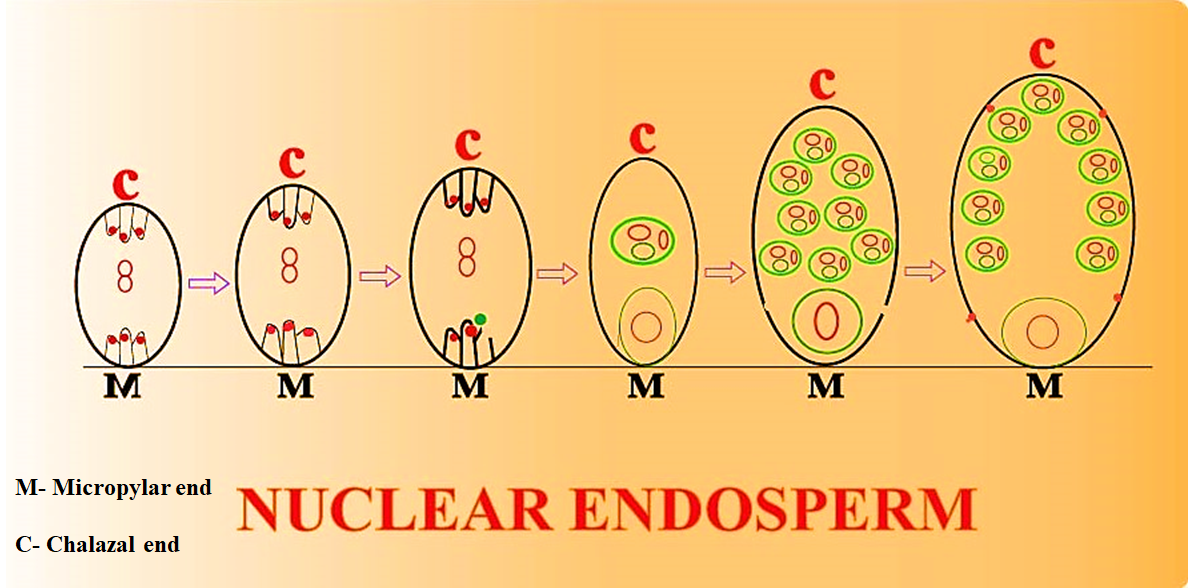Answer
425.1k+ views
Hint:The nuclear endosperm is also known as liquid endosperm as seen in coconut. In coconut, the peripheral endosperm is usually multicellular which is called ‘coconut meal’ while the central part called ‘coconut milk’ is free nuclear.
Complete answer:
The nuclear endosperm is formed by continuous mitotic free nuclear division of the PEN (primary endosperm nucleus) in the central cell of the embryo. Later, the formation of the wall takes place in centrifugal direction i.e. from the periphery of the embryo sac to the center. This is preceded by the formation of a large central vacuole that pushes the free nuclei to the peripheral cytoplasm.
It is the commonest kind of endosperm and is found mainly in polypetalous flowers such as cotton, wheat, sunflower, Zea mays, Capsella, Coconut, etc.
Additional information:
The other two types of endosperm are-
-Cellular endosperm- In this type of endosperm, the nuclear divisions are followed by immediate wall formation. It is seen in Petunia, Datura, Adoxa, etc.
-Helobial endosperm- It is an intermediate type of endosperm in which the first nuclear division is followed by wall formation but the subsequent nuclear divisions take place without any wall formation. It is seen in monocots like Asphodelus.
So, the correct answer is ‘Initially free-nuclear division followed by wall formation’.
Note:
-The endosperm acts as a source of nutrition to the developing seed and consists of starch (mainly), protein, and fatty oils.
-The endosperm of the majority of the angiosperms is triploid except for a few such as, in Nuphor polsepala, the endosperm is diploid.

Complete answer:
The nuclear endosperm is formed by continuous mitotic free nuclear division of the PEN (primary endosperm nucleus) in the central cell of the embryo. Later, the formation of the wall takes place in centrifugal direction i.e. from the periphery of the embryo sac to the center. This is preceded by the formation of a large central vacuole that pushes the free nuclei to the peripheral cytoplasm.
It is the commonest kind of endosperm and is found mainly in polypetalous flowers such as cotton, wheat, sunflower, Zea mays, Capsella, Coconut, etc.
Additional information:
The other two types of endosperm are-
-Cellular endosperm- In this type of endosperm, the nuclear divisions are followed by immediate wall formation. It is seen in Petunia, Datura, Adoxa, etc.
-Helobial endosperm- It is an intermediate type of endosperm in which the first nuclear division is followed by wall formation but the subsequent nuclear divisions take place without any wall formation. It is seen in monocots like Asphodelus.
So, the correct answer is ‘Initially free-nuclear division followed by wall formation’.
Note:
-The endosperm acts as a source of nutrition to the developing seed and consists of starch (mainly), protein, and fatty oils.
-The endosperm of the majority of the angiosperms is triploid except for a few such as, in Nuphor polsepala, the endosperm is diploid.

Recently Updated Pages
How many sigma and pi bonds are present in HCequiv class 11 chemistry CBSE

Why Are Noble Gases NonReactive class 11 chemistry CBSE

Let X and Y be the sets of all positive divisors of class 11 maths CBSE

Let x and y be 2 real numbers which satisfy the equations class 11 maths CBSE

Let x 4log 2sqrt 9k 1 + 7 and y dfrac132log 2sqrt5 class 11 maths CBSE

Let x22ax+b20 and x22bx+a20 be two equations Then the class 11 maths CBSE

Trending doubts
Fill the blanks with the suitable prepositions 1 The class 9 english CBSE

At which age domestication of animals started A Neolithic class 11 social science CBSE

Which are the Top 10 Largest Countries of the World?

Give 10 examples for herbs , shrubs , climbers , creepers

Difference between Prokaryotic cell and Eukaryotic class 11 biology CBSE

Difference Between Plant Cell and Animal Cell

Write a letter to the principal requesting him to grant class 10 english CBSE

Change the following sentences into negative and interrogative class 10 english CBSE

Fill in the blanks A 1 lakh ten thousand B 1 million class 9 maths CBSE



